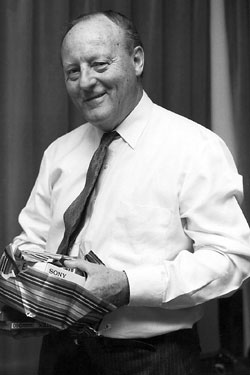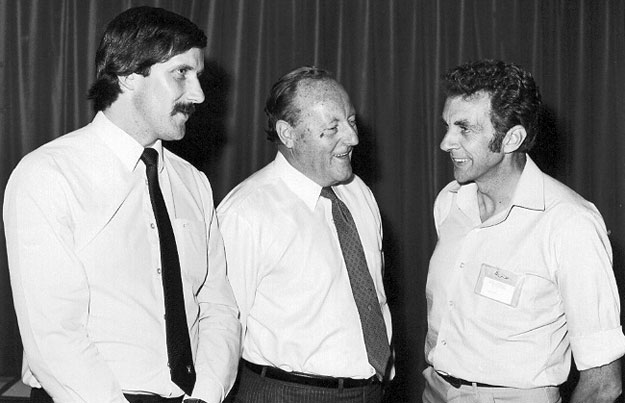
Born in 1923, Peter Riley completed his education at St.Kevin's College,
Toorak, and joined the Commonwealth Public Service. He was directed to
the Department of Civil Aviation, the head office of which, with a complement
of less than 100 staff, was then located in Almora House, 522-536 Little
Collins Street, Melbourne. It occupied two floors of the building.
It was 1940 and the staff was gradually being depleted with the enlistment of some of the young men to the services. Actually, the time was unique to the Public Service as the need to replace clerical staff brought about the introduction for the first time of female clerks. After serving 12 months Peter joined the AIF at age 18 and saw active service in New Guinea and Bougainville.
Left: Peter Riley retires from the Department on his 60th Birthday in 1983. (Photo: Peter Riley collection)
Returning to the Department in October 1945 he commenced work in the Division of Air Navigation and observed the developments taking place in the civil aviation world to satisfy post war needs. He worked for Arthur Affleck until some months later when the new position of Superintendent of Accident Studies was occupied by Wal Boud. It was the role of the new Directorate of Air Navigation Safety (DANS) to investigate minor accidents and to develop and operate a system which would bring to notice all incidents which could have affected the safe operation of aircraft. As the incidence of accidents at that time was not high, it was felt that a study of air safety incidents and the action taken could perhaps eliminate a subsequent disaster.
A system of punched cards was introduced which, at the completion of the investigation, were coded and would in subsequent review indicate those areas most likely to cause concern. The information was tabulated and passed to the appropriate division of the Department. The medium used was the Air Safety Incident Report (C.A. Form 225) which was submitted by the operational areas of the Department on all aspects of safety. Initially same 2000 reports were received annually and the practice was extended further with the introduction of the C.A. Form 225A which enabled pilots to also bring to notice those facets of safety which caused them concern.
In 1955 the Accident Studies Branch was combined with the Accident Investigation Branch and became the Division of Accident Investigation and Analysis with the dual responsibility of investigating all accidents and air safety incidents as well as conducting or arranging investigation of all incidents and aircraft defects. The results of these studies were published in a quarterly publication Summary of Aircraft Accidents and Incidents, which was the forerunner to the Aviation Safety Digest.
The Digest followed, under the direction of Alan Lum, and Peter became involved in assisting with the editing of articles and gathering photographs for the new publication, which proved to be very popular. In addition Peter was encouraged to undertake a course in statistical methods at Melbourne University. It proved of assistance with the research activities being conducted by officers of the Division.
In 1965 a change of direction was made with Peter's promotion to the position of Assistant Administrative Officer in the Establishments and Personnel Branch. The responsibility of the position included the oversight of all administrative services including printing, operational publications distribution, photography, overseas travel submissions, local travel arrangements and allowances, typing services, central registry, publications editing, staff and office security, staff financial estimates, typists, secretaries and telephony staff. In 1969, with a redistribution of duties, Peter was appointed Executive Officer (Administrative Services) and became directly responsible to the First Assistant Secretary (Management Services), Joe Martin. Apart from a general administrative role, Peter was called upon to undertake some more specialized activities, some of which are outlined below.
In 1971, following the introduction by Qantas of Boeing 707 aircraft on the Sydney-Perth-Johannesburg route in 1967, advice was received from that Company that they would no longer require facilities at the Cocos (Keeling) Islands for refueling purposes as the new aircraft had sufficient range to fly direct Perth-Johannesburg without refueling. It was official policy, however, to retain the airstrip as an alternate and for itinerant aircraft flying between Singapore and Australia.
There were some thirty staff and families associated with the airstrip resident on West Island, mostly DCA but also External Territories, Meteorology and Shell, as well as John Clunies Ross and 400 Malays on Home Island. Qantas had been responsible for bringing to the Islands fresh food, mail and sundry items. In addition Qantas had operated a hostel and meal facilities for visiting staff and supplied chefs, kitchen staff, baker and maintained supplies in the only shop on the Island. Additionally, families felt that they were not isolated, although 1,800 miles away from Perth in the Indian Ocean, as a twice-weekly service each way passed through the Islands.
After considerable investigation it became clear that the Department was not geared to employ and continuously replace this type of domestic staff and negotiations were entered into with Department of Labor and National Service to approach Commonwealth Hostels, who already maintained similar facilities in outback Western Australia, to undertake the task. After discussions with John Clunies Ross and the residents, an arrangement was entered into for Commonwealth Hostels to take over from Qantas. The next problem was the provision of an air service and, as Qantas were not prepared to continue and an approach to the RAAF for a weekly flight was turned down, TAA and Ansett were approached and it was agreed that a fortnightly service operated alternately by the two operators would commence. The only problem was the availability of an aircraft in Perth and this necessitated a charter flight by Lockheed Electra from Melbourne, and subsequently a Boeing 727 withdrawn from normal service at Perth to meet the need.
In the early '70s, following an attempted hijack of a light aero club aircraft by a passenger at Alice Springs, the decision was taken to increase security precautions at all major airports. Following discussions a policy was determined and the practices to be implemented included the provision of airport passes complete with photo, signature and 'home' airport indicated by color backdrop. These passes were to be issued to all DCA, airline and miscellaneous staff required to attend the airport. In all 2000 passes were produced and necessitated a number of visits by a production team to fifteen airports in Australia and New Guinea. In addition, a consolidated list was produced and liaison conducted with airport managers to ensure the continuity of the system.
With the growth in the aviation industry difficulty was experienced with the production, collation and distribution of publications, orders, instructions and other informative material. With some 15,000 recipients of publications, a varied distribution for each and amendment services distributed at varying times, manual distribution was a nightmare and subject to delays in processing and dispatch of information from Regional Offices. The existing system involved each addressee being the subject of a metal plate tabbed for the varying categories of licence etc. However, the Department was transferring to computer techniques and publications distribution became a high priority.
The responsibility for maintaining the licensing system was the responsibility of offices in the Regions, and in some cases offices at light aircraft fields. As a result, a system was devised for the appropriate licensing staff to complete forms for new and additional licence holders and ratings, as well as additions and deletions to the Register, change of address etc. Whilst the publications distribution role was the responsibility of the Admin section, it depended on staff of the operational branches to maintain an accurate file. This factor posed problems with the additional workload on the licensing clerks. However, with considerable goodwill and usage the new system, when introduced, proved beneficial in many ways.
A matter often overlooked, although a very simple one, is the collation and mailing of numerous amendment pages and copies of paper reports etc. The Publications Section had a continual problem with this task. Because the operational material was important and urgent, and required to be printed and dispatched within days if not hours, the Department had decided that this should be carried out "in house". At the time, printing houses were unable to cope with the time demands of the Department. However, staff recruited as clerical assistants were not happy to be saddled with this monotonous task, day after day, and sought employment elsewhere. It was clear that a lead should be sought from private industry who must surely have the same problem. It was revealed that the task was acceptable to "young mums" who were prepared to come in on an "as required" basis. An approach was made to the Public Service Inspector and when it was seen that no alternative was feasible approval was given for 20 positions to be utilized as necessary. This would appear to have been the first instance of part-time clerical assistance in the Service. It proved to be a very satisfactory arrangement.
Peter Riley retired in November 1983. In retirement he has been heavily involved in the work of the St. Vincent de Paul Society, and has served at State and National levels with that organization.

Above:
John Corin, Peter Riley & Stan Gibbs, of the Publications Production
Centre, c.1980s. (Photo: Peter Riley collection)
Back to the main Departmental People index
If this page appears without a menu bar at top and left, click
here